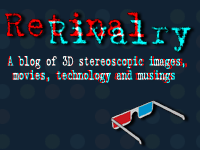On the Thursday of last month's LA 3-D Club meeting, I had the painful task of notifying the 3-D community that one of its brightest lights was no longer shining. Two days earlier, on Tuesday, November 13th, 2012, Ray Zone passed away at his home in Hollywood. Ray meant so much to so many people, and his influence spread well beyond our 3-D "family" here in Los Angeles. Ray was respected and admired around the world for his work, which covered the full spectrum of artistic endeavors, from comic books to fine art and music, and all of the photography, motion pictures, and history in between.
I first met Ray Zone ten years ago when I started attending LA 3-D Club meetings and I learned that 3-D was, quite literally, his middle name. Ray took me under his wing, mentoring me in all things stereoscopic. Over the next decade we ended up becoming very close friends. In many ways Ray was like a surrogate father to me, and in fact he sometimes called me one of his "3-D kids". We worked on many projects together - I had the privilege of starring in two of Ray's short films, and shooting and editing another for him, and he worked on several of my films. I also got to work with Ray on a number of 3-D conversion projects, including a pair of lenticular Presidential portraits that were displayed in the White House. We traveled or stayed together at many industy events including NAB, SD&A, Comic-Con and NSA conventions, and we made numerous treks to the Big Bear Film Festival. I will forever hold dear the in-depth conversations we had on those many road trips.
Ray always championed the low-budget, indie spirit, and a few years ago he and I came up with the idea of branding our work "3-DIY, Do-It-Yourself 3-D". Ray used that as the title of his book on the subject, and I was honored to be featured on the cover. We even started a 3-DIY YouTube channel together to showcase the work of 3-D filmmakers from around the world. Ray always liked to say that "Hollywood is full of 800-pound gorillas making mediocre content, while the 3-DIY chimpanzees are creating the innovative new work". He was always confident that the "chimpanzees" would find success, and I'm proud to be one of his chimps.
I was asked to write a brief biography of Ray for Stereoscopy magazine. The following barely scratches the surface:
Ray Zone was an author, 3-D film producer, speaker and award-winning 3-D artist. Starlog magazine called him the "King of 3-D Comics," and Artsy Planet named him the "3-D King of Hollywood." Born on May 16, 1947, he grew up in Cucamonga, California and was in the first graduating class of Alta Loma High School. He wrote for the Cucamonga Times about school happenings in a weekly article titled "Tepee Times," named for the Alta Loma Braves. Ray became interested in 3-D in 1953 when he read a 3-D Mighty Mouse comic book at age 6. He moved to Los Angeles in the early 1980's and began working in the world of 3-D converting flat art to 3-D images. His early collaborations with Jack C. Harris and Steve Ditko drew the attention of Archie Goodwin, who recruited him to work with John Byrne on the 1990 Batman 3-D, a full-length 3-D graphic novella. Ray produced 3-D adaptations of art for over 150 comic books, for clients such as Disney, Warner Bros and the Simpsons, and including stories by Alan Moore and Grant Morrison which were specifically written to accommodate stereoscopy. He also created stereo conversions and stereoscopic images for a wide variety of clients in publishing, education, advertising, television and motion pictures. In 2006 Ray Zone was acknowledged as "3-D Artist" on the platinum-selling Tool 3-D CD "10,000 Days" which garnered the Grammy in the category of "Best Recording Package." He was the recipient of numerous awards for his 3-D work, among them a 1987 Inkpot Award from the San Diego Comic-Con for "Outstanding Achievement in Comic Arts."
An internationally recognized expert in all things 3-D, Ray had a special interest in stereoscopic cinema and Large Format 3-D filmmaking. He wrote and directed a number of 3-D short films including Slow Glass (2006), Whatever Happened to Ro-Man (2009), and The Charlatan (2012). He also appeared in many other short and feature productions, both as an actor and as himself. In 2008 Zone worked as 3-D Supervisor on the feature film Dark Country (Sony Pictures) with director/star Thomas Jane and in 2010 as 3-D Producer on Brijes 3-D, (Ithrax/SDA), the first animated 3-D feature film made in Mexico. He was the author of "3-D Filmmakers, Conversations with Creators of Stereoscopic Motion Pictures" (Scarecrow Press: 2005), "Stereoscopic Cinema and the Origins of 3-D Film, 1838 - 1952" (University Press of Kentucky: 2007), "3-DIY: Stereoscopic Moviemaking on an Indie Budget" (Focal Press: 2012), and "3-D Revolution: The History of Modern Stereoscopic Cinema" (University Press of Kentucky: 2012). Ray served on the boards of many organizations including the National Stereoscopic Association, the Stereoscopic Society of America, the International 3D Society, and the LA 3-D Club.




